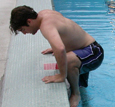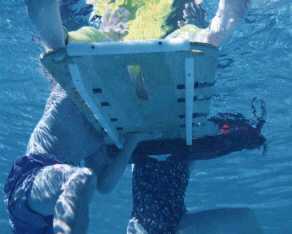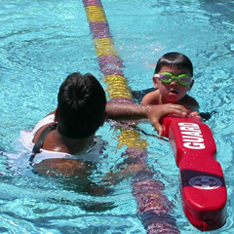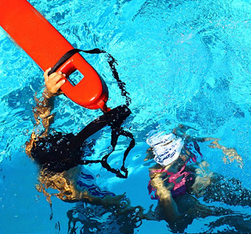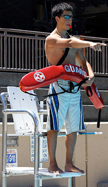

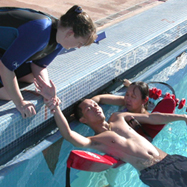
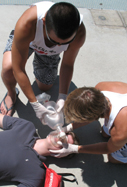
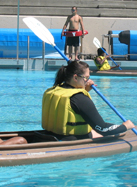
This page has advice and tips for passing lifeguard training prerequisite swim tests and written exams. The same tricks for Red Cross training also apply to YMCA, Ellis, USLA, Boy Scouts or Starguard tests.
Beware of places that offer totally online certification as a lifeguard. There are dozens of other brands that say they offer “full certification as a professional rescuer.” BUT if you ask at pools, waterfronts, beaches, summer camps, swim clubs, resorts you might want to work at you will find they do not accept many certifications. Be sure to check first where you want to work for which certifications they accept.

The Red Cross released a new Lifeguard Training certification program in early February 2024.
August 31, 2024: Basic level lifeguard courses based on the 2017 manuals are no longer being taught.
In the new materials we read:
“Course Prerequisites
To participate in the Lifeguarding (Including Deep Water) course, participants must:
▪ Be at least 15 years old on or before the final scheduled session of the Lifeguarding course.
▪ Successfully complete the two prerequisite swimming skills evaluations:
o Prerequisite 1: Complete a swim-tread-swim sequence without stopping to rest:
▪ Jump into the water and totally submerge, resurface then swim 150 yards using the front
crawl, breaststroke or a combination of both. (Swimming on the back or side is not
permitted. Swim goggles are allowed)
▪ Maintain position at the surface of the water for 2 minutes by treading water using only
the legs (Place your hands under your armpits. Your head and mouth must remain above the surface of the water. You need to maintain a “body position that is near-vertical.”)
▪ Swim 50 yards using the front crawl, breaststroke or a combination of both
o Prerequisite 2: Complete a timed event within 1 minute, 40 seconds:
▪ Starting in the water, swim 20 yards. (The face may be in or out of the water. Swim
goggles are not allowed)
▪ Surface dive (feet-first or head-first) to a depth of 7 – 10 feet to retrieve a 10-pound
object.
▪ Return to the surface and swim 20 yards on your back to return to the starting point,
holding the object at the surface with both hands and keeping the face out at or near the
surface. Swimming the distance underwater is not permitted.
▪ Exit the water without using a ladder or steps
Note: “If the Lifeguarding course includes training for the Waterfront Skills module, additional prerequisite swimming distances and skills are required.”
![]()
Please note that for competitive swimmers “freestyle” can mean a stroke of the swimmer’s choice, but for these swim tests it means front crawl.
To become a Red Cross lifeguard, do I have to have a perfect freestyle?
No. The instructor’s manual says that the lifeguard candidate “swims with the face in the water and demonstrates breath control (slight hesitation during breathing is acceptable),” but it does not say you must breathe to the side perfectly on your freestyle / front crawl.
It also says you need to demonstrate “comfort in deep water”, and you need to maintain a body position “that is nearly horizontal to the surface”. Your arms should come up out of the water on freestyle recovery. Your leg action “should contribute to forward motion.”
Each of the swim tests are “continuous” swims. You can’t stop swimming, stop at the side, or hold on to a rope / lane line or stand on the bottom.


Do I have to be a fast swimmer?
People in my swimming classes tried the tests and most were within the required times, even some of the students in beginning swimming who thought they were not yet a good swimmer.
For each of the prerequisite swim tests, the instructors manual says “If a participant does not successfully complete the prerequisite swimming skill evaluation, the instructor may provide other opportunities to meet the prerequisites, after sufficient rest as time permits and prior to the first scheduled class session.”
Many people find their initial attempt at the test that involves getting the weight from the bottom is awkward, so we practice it in swim classes. (The ten pound weight used is often a brick shape, but with rounded or smoothed edges. Ten pounds is the standard weight for lifeguard tests since people weigh about ten percent of what they do on land when in the water, so the ten pounds would represent about a 100 pound person. Why do you weigh only about 10%? Because your bones and muscles are denser than the water and your air in your lungs and body fat are lighter than the water.)
Perhaps of interest: you CAN float.
- We can teach you how to do a faster, more effective surface dive before you take the test.
-
- There are a couple of easy ways to climb out of a pool and many hard ways. In a De Anza swim class we can teach you the easy ways and work on gaining strength/speed in climbing out. You do not need the upper body strength to be able to do a full pushup on the pool deck and climb out. You can instead put a knee on the edge of the pool gutter and a forearm on the deck, then put your other foot on the gutter and your hands on the deck and step up from there,
-
- or whatever other kind of contortionist move you invent.
- You just can’t use the steps or a ladder during testing.
What if I’m out of shape? Students in my swim classes work towards being able to pass the tests and even practice some of the skills. Consider starting with KNES1B
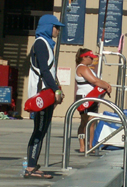
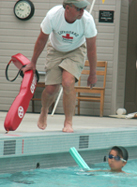
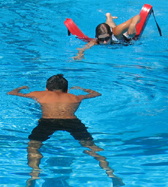
![]()
____________________________________________________________
The minimum age to become a Red Cross trained lifeguard is 15 years old
on or before the last day of class.
There is no maximum and the class is great for retirees
who want extra income without frying fast food.
You will need to bring proof of your age to the training, it needs to be a photo ID, government issued, such as a a driver’s license, state identification, or passport.
____________________________________________________________
What are the Red Cross lifeguard certification written tests like?
The Red Cross certification tests are multiple-choice. 80% is passing. (For most Red Cross exams you can have two tries if you need them, but they will be two at least slightly different tests.)
Go to How to pass a Red Cross written test for more info.
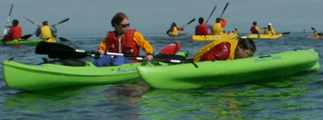
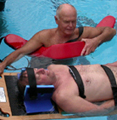

More about the Red Cross prerequisite swim tests:
For some of the pre-tests you can wear goggles, for others you can’t. You will not be allowed to wear goggles for any skills training or final testing during the lifeguard course.
The Red Cross warns: Goggles “are not made for underwater swimming. There is no way to equalize the pressure inside the goggles with the increasing pressure outside the body. The air volume inside the goggles tends to compress. This compression tends to “pull” the eyeball out of the socket to effectively reduce the trapped air volume. If swimmers spend time below the surface of the water wearing goggles they may pop blood vessels in their eyes. Goggles should not be worn for underwater swimming . . . Submerging to a depth of 5 feet or greater has the potential to cause barotraumas to the eye of an individual wearing swim goggles that cannot be pressure equalized.”
(Also, a lifeguard would not have the time to put on goggles just before they do a rescue, and would not wear them all the time to guard.)
Wearing your contact lenses to swim or in a lifeguard class is dangerous. The Red Cross warns: “Swimmers with contact lenses should remove them before opening eyes underwater.” Pool chemicals can damage some kinds and others will absorb bacteria, leading to infection. All brands of goggles can leak or slip off, even if you wear them tightly and do not fully protect contact lenses.
Lifeguard training students should remove all piercings, but at least those that protrude from your body (example: you might be safe with a flat ear stud, but not with loop earrings). Read body piercings and lifeguards to help you determine which piercings you will remove:
http://www.aquaticsintl.com/lifeguards/saving-your-skin.aspx
You should not expect to be allowed to use noseplugs or earplugs. In deep water earplugs can be forced by water pressure into your ear. The Red Cross warns: “Do not wear earplugs; pressure changes make them dangerous.”
 (The larger of the two De Anza pools, the ‘Olympic sized’ pool, is 50 meters long by 25 yards wide. A 100 yard swim would be across the width of the big pool and back twice.)
(The larger of the two De Anza pools, the ‘Olympic sized’ pool, is 50 meters long by 25 yards wide. A 100 yard swim would be across the width of the big pool and back twice.)
– – – – – – – – – – – – – – – – – – – – – – – – – – – – – – – – – – –

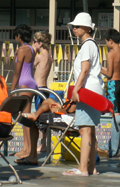
– – – – – – – – – – – – – – – – – – – – – – – – – – – – – – – – – – –


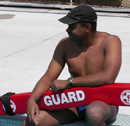
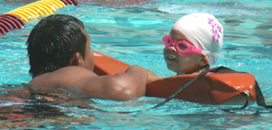
Advice for passing the lifeguard prerequisite swim tests:
The Red Cross used to have a number of other speed/endurance tests, but they were dropped. We still try to pass all the old time tests because employers may ask you to do them and we want you to have the confidence that comes from knowing you can pass most tests given. Most people can’t do them at the beginning of class, but with work most can by the end of the quarter. Either way, the old tests don’t count for your grade or certification.
The following advice applies to the prerequisite swim test
and potential ones that a pool might ask you to complete when you apply for a job:
- Take your time on the swim-tread-swim sequence. Don’t tire yourself out trying to sprint on the first test, and then be too tired for the second one. Red Cross rules say you can wear goggles for the continuous swim, but not during the ten pound weight retrieval.
- The De Anza College pool is 25 yards across. The weight will be on the bottom at 20 yards. People have gotten so excited they swam past the weight all the way to the wall. Learn from their mistake.
- On the surface dive for the weight at 7 feet, avoid the temptation to swim down just far enough to grab it. It’s easier and faster to swim to the bottom, grab the weight with both hands, put your feet on the bottom, and push hard with your legs. If you have enough air, push up to the surface at an angle in the direction you will be returning with the weight. If you feel out of breath, push up to the surface straight. You must keep both hands on the weight for the swim back to the side until you place the weight on the deck.
Before lifeguard candidates take the swim and get the weight test, they should ‘clear’ their ears (equalize the pressure) before they feel the pressure change. I will describe clearing your ears the first day. Please talk to me personally if you don’t understand how to do it, or if it doesn’t seem to work when you try it in the water.
- The best way to return with the weight is to swim on your back using a whip kick or eggbeater. A sidestroke scissors kick or elementary backstoke whip kick can also work. A flutter kick is probably too slow for most people, but a few of my students have been successful with it.
- You will be faster if you are horizontal instead of diagonal in the water. You are more likely to be more horizontal if you hold the weight near the top of your chest, instead of down towards your waist.
- You don’t want to swim under a lane line by mistake as it will slow you down and can surprise you and cause you to drop the weight, so look back and forth at the lane lines a little as you go.
- At the finish, be in the center of the lane. If you are too far to the side you can whack your elbow on the lane line as you do your pushup on the gutter to climb out and that can also slow you down.
- Yup, dropping the weight and having to get it from the bottom also slows you down.
- Wearing a swim cap makes you faster and keeps hair out of your face.
- You might have a partner to in the water at the finish of the swim to protect your head from hitting the wall, but your partner also needs to stay out of your way as you climb out of the pool.
- Don’t hyperventilate (multiple, rapid, deep breaths) before you swim under water. You can’t store extra oxygen that way, and you can possibly pass out under water.
– – – – – – – – – – – – – – – – – – – – – – – – – – – – – – – – – – –
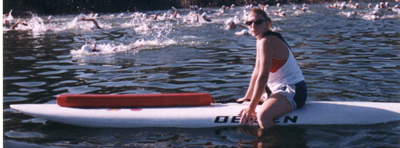

 (The waterfront guard certification required a trip to the beach to complete some skills that can’t be done at the De Anza pool. waterfront lifeguard practice May 16, 2010)
(The waterfront guard certification required a trip to the beach to complete some skills that can’t be done at the De Anza pool. waterfront lifeguard practice May 16, 2010)
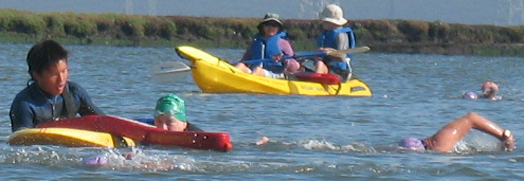
Doesn’t a lifeguard need a lot of physical strength?
Isn’t it difficult to rescue a heavy person who is sinking to the bottom of a pool?
![]() No, the rescue tube, handled properly, provides enough flotation to get the victim to the surface. Go to: How to rescue a submerged victim
No, the rescue tube, handled properly, provides enough flotation to get the victim to the surface. Go to: How to rescue a submerged victim
Do lifeguards have to know how to dive?
No. Most of the time a lifeguard will enter the water in other than a dive. A racing dive like they use on a swim team isn’t very useful for a lifeguard, since we need to be able to see the victim as we enter and approach them. Sometimes we need to enter extra carefully (in case of a spinal injury victim, for example). You will be taught all the methods of entry.
If I have the time, what can I do to get ready for lifeguard training?
Most people do nothing, but you could work on laps of sidestroke, freestyle with your head up and aim towards being able to tread water with no hands. Try some push-ups on the pool gutters or deck for strength climbing out of the pool.
Many students in my De Anza College swim classes work on the prerequisite swim test and lifeguard skills whether they will be taking lifeguard training from me, or just want to see if they can pass the Red Cross (or YMCA) prerequisite lifeguard swim test(s). Some of the things we can work on in swim class are at: Get ready for lifeguard training.

When is lifeguard training offered at De Anza College?
Due to budget problems, lifeguard training is no longer offered. (I am training lifeguard instructors off campus regularly.)
How do I enroll at De Anza to take a swim class to prepare for lifeguard training?
If you haven’t ever been a De Anza student, or were here before, but not the most recent quarter, you must first apply to the college. If you have not been accepted as a De Anza student, you can’t just show up the first day of class and be automatically added, so do the paperwork online beforehand when you won’t have to stand in a line.
Registration steps are at: http://www.deanza.fhda.edu/admissions/
High school students in their junior and senior years have been able to take De Anza Saturday swim classes. Go to: https://www.deanza.edu/outreach/concurrent_students.html
For information on concurrent enrollment at De Anza College while attending a Fremont Union High School District High School (Cupertino, Lynbrook, Monta Vista, Fremont and Homestead), go to:
https://www.fuhsd.org/concurrent
This webpage might be of assistance in convincing a high school principal or counselor.
How to get a locker, how to find the pools, sunscreen, Pass/No Pass grading, waitlists and more are covered at
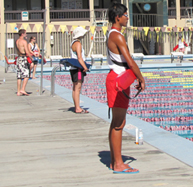
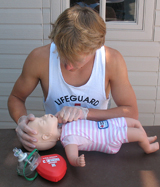
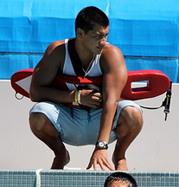
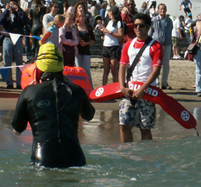
Some people take a lifeguarding class for fun, exercise, or just for skills they can use the rest of their lives living and playing around water, being a scout leader, camp counselor or recreation leader.
A scout group can do so many more water, boating activities if they have a lifeguard (for example a parent).
Butterflies can be seen sometimes trying to dip down toward a swimming pool surface and sometimes can’t fly away. We suggest that if you want to rescue a butterfly shrugging on a pool surface you do not try to catch it with your fingers, but instead dip your arm down in the water under it, then lift your arm to the side of the pool and wait for it to flutter its wings and dry out enough to fly off:![]()
The butterfly above appears to be a California Sister (Adelpha californica).
The author of this webpage, (written as a homework reading assignment for my students), does not give any warranty, expressed or implied, nor assume any legal liability or responsibility for the accuracy, completeness, or usefulness of any information, product, or process included in this website or at websites linked to or from it. Users of information from this website assume all liability arising from such use.

